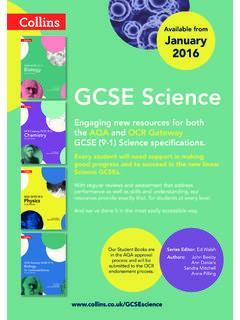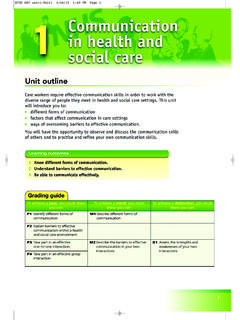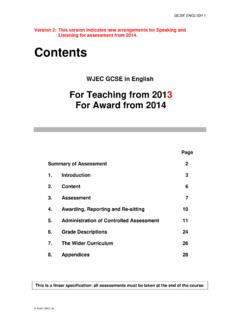Transcription of AQA GCSE English Language and English Literature
1 Teacher GuideAQA GCSEE nglish Languageand English LiteratureSeries Editors: Sarah Darragh and Jo HeathcoteSarah Darragh, Phil Darragh,Mike Gould and Jo Heathcote209295_Teacher 512/11/14 11:45 AMSample content HarperCollinsPublishers 2015 Explaining and commenting on writers methods and effects LESSON 1 Core Student Book CHAPTER 4 Explain and comment on writers use of Language Assessment objectives English Language AO2 Explain, comment on and analyse how writers use Language and structure to achieve effects and influence readers, using relevant subject terminology to support their views gcse examinations English Language Paper 1, Questions 2 and 3 English Language Paper 2, Question 3 Differentiated learning outcomes All students should aim to demonstrate awareness of the writer s viewpoint and be able to refer to one or two appropriate words and phrases from the text.
2 Most students should clearly explain the writer s viewpoint, using some relevant examples from the text to support their ideas. Some students could offer interpretations of the writer s viewpoint and make detailed comments about a range of carefully selected words and phrases to support their interpretation. Resources Student Book: pp. 116 19 Worksheet: PPT: Getting you thinking PPT Display PPT , slide 1. Ask students to suggest words that they might use to describe what they see. Discuss as a class what it might feel like to live in a place like the one in the photograph. Introduce the main questions students should ask when reading a text for the first time: What is the writer s viewpoint? How does the writer want me to think or feel? Big question Start with the Big question: Why does it matter which words and phrases the writer chooses? Give students a few minutes to discuss the question in pairs before they write a short answer.
3 Explain that you will be returning to this question at the end of the lesson. Ask students to read the first extract from The Road to Wigan Pier in the Student Book (p. 116), or read it aloud if preferred. It might be useful to explain here that the image from PPT is of a pottery town at the time Orwell is describing. PPT Display PPT slide 2, which is a checklist of strategies to use when reading a new text for the first time. Refer students to Q1 and Q2. Give students five minutes to respond to these two questions in pairs or a small groups, before sharing their ideas with the class. The responses could be collated onto a whiteboard for later reference. Explore the skills Read the next section of The Road to Wigan Pier (Student Book p. 117). Make sure students are familiar with the terminology by drawing attention to the Key term explanation of adverbials.
4 It might also be useful to take an example of each of the other techniques listed in the first column of the table first before students begin their independent work in Q3. Students can either copy the table or use Worksheet to complete the second column. The Key term effect is central to this part of the lesson and to following lessons. Students can slip into making vague comments on effect without grasping exactly what it means. Using this point in the lesson to reinforce what effect means can pay dividends later on in the chapter, and elsewhere. Remind students that it refers to the effect that the word or phrase has on the reader: the mood or tone it creates; Uncorrected proof2 Explaining and commenting on writers methods and effects LESSON HarperCollinsPublishers 2015 Core Student Book CHAPTER 4 the thoughts and feelings it provokes in the reader; the picture the reader is encouraged to have of what is being described.
5 Develop the skills PPT Display PPT , slide 3 and ask students to read the sample answer. As they read, ask for responses to Q4. This is an opportunity to dig deeply into the meaning of effect and for students to explore ways of writing effectively about it. Students can now respond to Q5 by returning to their table and selecting two examples that they identified to make notes about their effect. Stress at this point that they should focus on selecting useful material a word/phrase that can be considered in detail and linked effectively to the writer s purpose rather than aiming for blanket coverage. This is the most important part of becoming a good, critical writer. It doesn t matter if students tables are not complete; they are merely using the table to note down their ideas as part of a discerning selection process. Allow ten minutes for students to compete Q6, working independently.
6 Refer to the Checklist for success as an aide memoire that students can use before they begin their written task. If time allows, select some responses to share with the class at this point, pointing out what is working well and where students have dealt with the idea of effect clearly. Apply the skills Read out the main task and make a note of it on the board. Stress the key words in the task: how, use Language and viewpoint. Elicit that Language means the effect of particular word choices as well as Language techniques. Look at the plan in the Student Book relating to Orwell s use of Language (p. 119) and identify the good practice: being clear about what the writer s viewpoint is (point 1) and how the effect is created (points 2 4). Give students ten minutes to look at their notes and plan their responses (Q7). Emphasise again that it is about selecting the most useful, effective bits of evidence to illustrate how the writer s viewpoint is created rather than trying to cover every single word a writer uses.
7 Give extra support by keeping the model answer on display so students can use this to scaffold their own writing. Give extra challenge by asking students to make sure they include relevant technical vocabulary from this section as part of the response. Allow 15 minutes for students to work independently on Q8, crafting their answer to the task. Students could use the first sentence of the plan in the Student Book (p. 119) to help them start if necessary. Big answer plenary Ask students to use the Check your progress ladder at the end of the section to position their response on either Ladder 1, Ladder 2 or Ladder 3. When they have done this, they should share their work with a partner and ask the partner also to decide which ladder rung the work should be placed on. Ask students to discuss their work in pairs and identify one strategy for improvement. Refer back to the Big question from the start of the lesson and ask students to write a sentence beginning with: The words and phrases a writer chooses are essential Uncorrected proof HarperCollinsPublishers 2015 Explaining and commenting on writers methods and effects LESSON 3 Core Student Book CHAPTER 4 Explain and comment on writers use of Language techniques Assessment objectives English Language AO2 Explain, comment on and analyse how writers use Language and structure to achieve effects and influence readers, using relevant subject terminology to support their views gcse examinations English Language Paper 1, Questions 2 and 3 English Language Paper 2, Question 3 Differentiated learning outcomes All students should aim to show awareness of the writer s ideas and identify two or more Language techniques.
8 Most students should demonstrate clear understanding of the writer s ideas and comment in some detail on how Language techniques are used to communicate these ideas to the reader. Some students could show real engagement with the writer s ideas and be able to explain clearly how specific Language techniques have been used to communicate these ideas to the reader. Resources Student Book: pp. 120 3 Worksheet: PPT: Getting you thinking Big question Draw attention to the Big question and ask students to explain what they think a Language technique might be. They may offer some examples. These could be collated on the board for reference as the lesson proceeds. At this stage it might be worth returning to the idea of effect from the previous lesson and reminding students that it is important to explain what the effect of a particular choice actually is, rather than simply saying the writer does this for effect.
9 Ask for some definitions/examples of rhetorical techniques. A brief explanation of rhetoric (the art of persuasion) may be useful if students are unfamiliar with the term. The Key terms box provides a definition to support this activity. Ask students to look at Q1 and to identify the technique (rhetorical question). Ask students to discuss Q2 and Q3 in pairs before sharing ideas with the rest of the class. Students might mention ideas about hyperbole/exaggeration here, or the ridiculousness of the question, or the shock that might come from the mental picture created by the rhetorical question. Draw students to the understanding that, clearly, the writer sees that the question is ridiculous, and therefore it doesn t require an answer. Explore the skills Allow ten minutes for students to work through Q4, either independently or in pairs. Ask them to make notes as they consider each question.
10 Give extra support by ensuring that students understand the terms direct address and first person. Give extra challenge by focusing attention on the third question, which is more challenging than the first two. Uncorrected proof4 Explaining and commenting on writers methods and effects LESSON HarperCollinsPublishers 2015 Core Student Book CHAPTER 4 Develop the skills Read the next two paragraphs of the article with the class. As you read, allow time to pause and consider each annotation. Allow around ten minutes for the class to read the rest of the article, and its annotations, independently. As they read, students should be encouraged to consider which of the eight annotated features they think they might be able to write a short paragraph about. Encourage them to choose one or two features that can be linked really clearly to the writer s overall purpose.

















